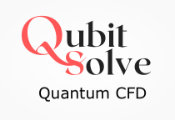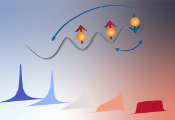SandboxAQ Publishes Scientific and Technical Milestones for Quantitative Methods
Palo Alto, CA, December 5, 2024 – SandboxAQ today announced a series of scientific and technical milestone publications, collectively marking a set of significant advances in the company’s core research and product development activities. These achievements unlock new methods for biopharma drug discovery as well as development of new materials and battery chemistry.
SandboxAQ and its partners have been at the forefront of scientific and computational advancements, pushing the boundaries in multiple technical areas. At the time of their spinout in 2022, they set new records in quantum chemistry, including the largest-ever N3 DFT simulation, and scalings-up of the density matrix renormalization group (DMRG) method to unprecedented sizes. Since then, they have built on these achievements with a number of advances, producing practical impact across drug discovery, materials discovery, and beyond.
Geoff Ling, Founding Director of the Biotech Office at DARPA, said: “The cross-cutting nature of SandboxAQ’s Large Quantitative Models is a game-changer for innovation in biopharma, materials science, and beyond. SandboxAQ’s bench of PhDs and engineers are delivering deep science breakthroughs that are evident in their published research and collaborations. The ability to harness such advancements not only strengthens the United States and our allies but also sets the stage for a new era of global scientific collaboration and industrial leadership.”
Quantum Chemistry: Absolute Free Energy Perturbation for Molecular Screening
The first paper to highlight focuses on SandboxAQ’s absolute free energy perturbation (FEP) solution, AQ-FEP. AQ-FEP computes the binding affinity between a drug molecule and a protein, thus predicting the potency of the drug. But unlike its predecessors, AQ-FEP is an absolute method, and therefore does not require comparison to known or experimental measurements to get started, enabling the exploration of novel unprecedented chemistries.
Since AQ-FEP also enjoys order-of-magnitude speed improvements over other solutions, SandboxAQ is able to screen libraries of tens of thousands of molecules at a time with FEP accuracy. When combined with an AI solution that learns to reproduce this FEP accuracy on the fly over the course of a virtual screen as described in Machine Learning Guided AQFEP: A Fast and Efficient Absolute Free Energy Perturbation Solution for Virtual Screening, this can be extended to millions or billions of molecules, even over highly complex and historically undruggable targets.
Drug Discovery: Multi-Objective Molecular Design for Binding Affinity Measurement
SandboxAQ has also demonstrated its prowess in generative AI, via its multi-objective molecular design solution, IDOLpro. Instead of scanning through a library, as does AQ-FEP, IDOLpro outputs completely new molecules from whole cloth, in the same way as other generative models might output text or images. IDOLpro outputs molecules with 3.4x binding affinity compared to state-of-the-art methods, exceeding even the experimentally measured binding affinities from its own training data. But most importantly, IDOLpro by design allows its output to be further conditioned by additional filters for synthetic accessibility, selectivity, and druggability, meaning that the molecules it outputs can be used by medicinal chemists in practice.
Material and Chemical Discovery: Large Quantitative Models (LQMs) for Lab-Accurate Quantum Chemistry
At SandboxAQ, we’re training deep learning molecules on data from millions of quantum-level chemical calculations. Achieving this requires advances in both AI models, trained on both first-principles simulated and experimentally measured data, to predict useful materials properties. To this end, SandboxAQ has demonstrated its ability to run lab-accurate quantum chemistry at massive scale, by simulating the breakdown of toxic PFAS “forever” chemicals on over one million cloud vCPUs. See the technical blog on AWS.
This gives our team and our partners the ability to probe some of the smallest components of our universe – atoms and molecules – with unprecedented accuracy, allowing researchers to anticipate how a material will behave before it's ever built in the lab. This technology has been applied by the U.S. Army to create strong and lightweight alloys for vehicular armor and develop advanced battery chemistries for next-generation energy solutions. Additionally, this technology enabled Dainippon Ink and Chemicals, Inc. to accurately calculate transition metal complexes, revealing limitations of conventional methods and advancing catalyst design for industrial innovation. See the technical blog on AWS.
Complex Biochemical Simulation: Density Matrix Renormalization Group (DMRG) Algorithms for Battery Lifecycle Testing
SandboxAQ has also used the DMRG algorithm to accelerate simulations of complex biochemical systems such as transition metal metalloenzymes, directly in collaboration with NVIDIA on distributed GPU hardware. These highly-accurate first principles models have been used by SandboxAQ to predict chemical and materials properties such as battery lifecycles, as in this paper developed in collaboration with battery manufacturer NOVONIX. SandboxAQ’s battery lifecycle LQM enables predictions with 35x greater accuracy and 50x less data than would traditional AI models, reducing testing time for new batteries by 95%.
Adam Lewis, Head of LQM Research at SandboxAQ, said: “Our Large Quantitative Models have proven indispensable in domains where reliability and predictive accuracy are critical, including in battery technology, where failure can have catastrophic consequences. For example, by performing precise predictions of battery performance and lifecycle, we’ve enabled time, resource, and even life-saving breakthroughs. These advancements underscore the transformative potential of LQMs across diverse fields.”
SandboxAQ’s unique LQM approach – training AI on first-principles and experimentally measured data – is already creating disruptive impact throughout science and industry, both in the life sciences and in chemical and materials discovery. Since quantitative and scientific modelling speaks to almost every industry of the world economy, these advances are poised to bring disruptive impact exceeding that of generative language and image modelling. Watch this space!




































